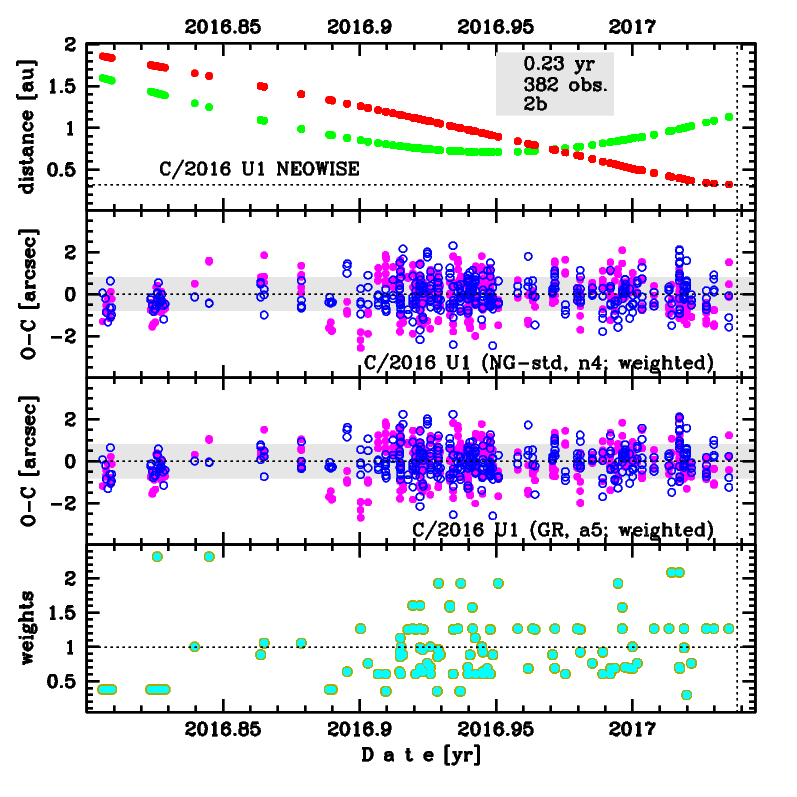C/2016 U1 NEOWISE
more info
Comet C/2016 U1 was discovered on 21 October 2016 by Near-Earth Object Wide-field Infrared Survey Explorer, that is less than 3 months before its perihelion passage, and was astrometrically observed until 12 January 2017. Comet had closest approach to the Earth on 13 December 2016 (0.709 au, about a month before the perihelion passage).
Sekanina (2019) concluded that this comet was a rare example of a comet that survived its perihelion passage despite a small distance from the Sun at that moment (see his Tables 2 and 6).
Despite short data arc this is a comet with NG effects determinable using positional data fitting. Both solutions (GR and NG) are based on data spanning over 0.227 yr in the pre-perihelion orbital leg, in a range of heliocentric distances from 1.86 au to 0.321 au.
GR assumption gives original hyperbolic orbit; however, NG orbit results in original semimajor axis of about 1900–3300 au (uncertainty of one sigma is used). C/2016 K1 suffers moderate/large planetary perturbations while passing through the planetary system; these perturbations probably lead to escape the comet from the planetary zone on a hyperbolic orbit (see future barycentric orbits).
Sekanina (2019) concluded that this comet was a rare example of a comet that survived its perihelion passage despite a small distance from the Sun at that moment (see his Tables 2 and 6).
Despite short data arc this is a comet with NG effects determinable using positional data fitting. Both solutions (GR and NG) are based on data spanning over 0.227 yr in the pre-perihelion orbital leg, in a range of heliocentric distances from 1.86 au to 0.321 au.
GR assumption gives original hyperbolic orbit; however, NG orbit results in original semimajor axis of about 1900–3300 au (uncertainty of one sigma is used). C/2016 K1 suffers moderate/large planetary perturbations while passing through the planetary system; these perturbations probably lead to escape the comet from the planetary zone on a hyperbolic orbit (see future barycentric orbits).
| solution description | ||
|---|---|---|
| number of observations | 382 | |
| data interval | 2016 10 21 – 2017 01 12 | |
| data type | observed only before perihelion (PRE) | |
| data arc selection | entire data set (STD) | |
| range of heliocentric distances | 1.86 au – 0.321au | |
| type of model of motion | NS - non-gravitational orbits for standard g(r) | |
| data weighting | YES | |
| number of residuals | 757 | |
| RMS [arcseconds] | 0.80 | |
| orbit quality class | 2b | |
| orbital elements (heliocentric ecliptic J2000) | ||
|---|---|---|
| Epoch | 2017 02 16 | |
| perihelion date | 2017 01 14.01874575 | ± 0.00053371 |
| perihelion distance [au] | 0.31910954 | ± 0.00001867 |
| eccentricity | 1.00027771 | ± 0.00003486 |
| argument of perihelion [°] | 162.753685 | ± 0.001491 |
| ascending node [°] | 61.421083 | ± 0.001838 |
| inclination [°] | 46.429166 | ± 0.001445 |
| reciprocal semi-major axis [10-6 au-1] | -870.25 | ± 109.24 |

Upper panel: Time distribution of positional observations with corresponding heliocentric (red curve) and geocentric (green curve) distance at which they were taken. The horizontal dotted line shows the perihelion distance for a given comet whereas vertical dotted line — the moment of perihelion passage.
Middle panel(s): O-C diagram for a given solution (sometimes in comparison to another solution available in CODE), where residuals in right ascension are shown using magenta dots and in declination by blue open circles.
Lowest panel: Relative weights for a given data set(s).
Middle panel(s): O-C diagram for a given solution (sometimes in comparison to another solution available in CODE), where residuals in right ascension are shown using magenta dots and in declination by blue open circles.
Lowest panel: Relative weights for a given data set(s).
| non-gravitational parameters | ||
|---|---|---|
| A1 [10-8au/day2] | 2.7007 | ± 0.67 |
| A2 [10-8au/day2] | 0.84086 | ± 0.14519 |
| A3 [10-8au/day2] | 0 | (assumed) |
| m | -2.15 | |
| n | 5.093 | |
| k | -4.6142 | |
| r0 [au] | 2.808 | |
| α | 0.1113 | |